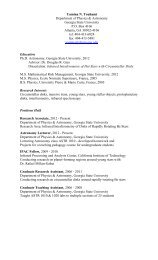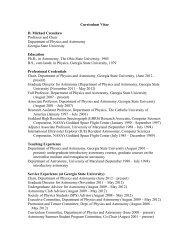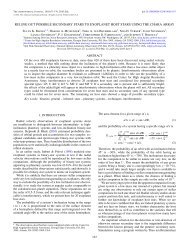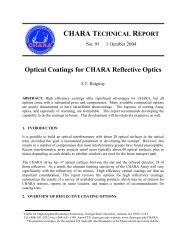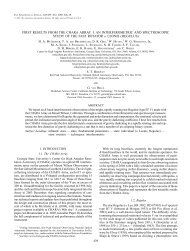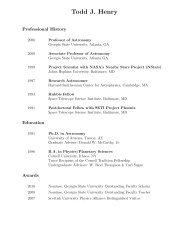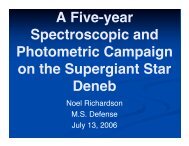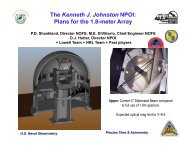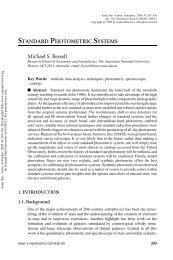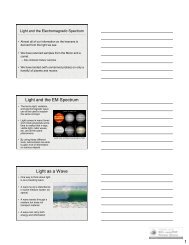PAVO, SUSI and ROCS: Status and Future Plans
PAVO, SUSI and ROCS: Status and Future Plans
PAVO, SUSI and ROCS: Status and Future Plans
Create successful ePaper yourself
Turn your PDF publications into a flip-book with our unique Google optimized e-Paper software.
CHARA Collaboration Year-Five Science Review<br />
<strong>PAVO</strong>, <strong>SUSI</strong> <strong>and</strong> <strong>ROCS</strong>:<br />
<strong>Status</strong> <strong>and</strong> <strong>Future</strong> <strong>Plans</strong><br />
Mike Irel<strong>and</strong>…<br />
+ Peter Tuthill, Theo ten<br />
Brummelaar, Gordon<br />
Robertson, Gail Schaefer,<br />
Antoine Mer<strong>and</strong>, Daniel<br />
Huber, Nathan Buttersworth,<br />
Aaron Rizzuto… + thanks to<br />
Judit, Nils, etc…
CHARA Collaboration Year-Five Science Review<br />
Outline…<br />
• The <strong>PAVO</strong> concept (slightly tricky)<br />
• <strong>PAVO</strong>@CHARA implementation<br />
• Data analysis progress<br />
• Intro to <strong>SUSI</strong><br />
• <strong>PAVO</strong>@<strong>SUSI</strong> implementation<br />
• Remote observing at <strong>SUSI</strong><br />
• <strong>Future</strong> expectations
CHARA Collaboration Year-Five Science Review<br />
<strong>PAVO</strong><br />
Precision Astronomical Visible Observations … or a<br />
peacock …or a turkey<br />
Goal at CHARA is to<br />
beat VEGA by:<br />
• Factor of 2 in sensitivity.<br />
• Factor of 2 in accuracy.<br />
• Factor of 2 in observing cadence<br />
for same S/N.<br />
(but no high spectral resolution<br />
mode)
CHARA Collaboration Year-Five Science Review<br />
Timeline…<br />
• Jan 2007: Concept for ARC proposal<br />
• May 2007: Hal <strong>and</strong> Theo agreed to channel<br />
Keck vis combiner money to <strong>PAVO</strong> prior to<br />
ARC announcement<br />
• August 2007-Jan 2008: Construction<br />
• March-July 2008: Commissioning<br />
• Aug-Dec 2008: Shared risk science
CHARA Collaboration Year-Five Science Review<br />
<strong>PAVO</strong> Optical Concept<br />
Quick Intro:<br />
1) The <strong>PAVO</strong> beam-combiner places 2 (<strong>SUSI</strong>) or 3 (CHARA)<br />
star images beside each other.<br />
2) The images pass through a mask, which acts as a spatial<br />
filter<br />
3) Fringes are formed in a pupil-plane<br />
4) An IFU turns these fringes into a data cube, with an image of<br />
the fringes at every wavelength (R~50, 620-950nm)
CHARA Collaboration Year-Five Science Review<br />
<strong>PAVO</strong>: Precision Astronomical Visible Observations<br />
Output 1 Output 2<br />
Difference Signal<br />
• <strong>SUSI</strong>/CHARA Classic… Full pupil summed in a two “pixels”, temporal modulation.<br />
• <strong>PAVO</strong>: 120 (<strong>SUSI</strong>) <strong>and</strong> 6000 (CHARA) pixels over the pupil, spatial modulation.<br />
• Spectral dispersion enables group-delay tracking.<br />
Pupil fringes at single wavelength<br />
Broad-b<strong>and</strong> Fringes after IFU<br />
Integral Field Unit<br />
CHARA: 16 lenslets<br />
Think of a data cube
CHARA Collaboration Year-Five Science Review<br />
Notes: Spatial-filtering 1<br />
• The image-plane spatial filter is a pinhole spatial-filter, that should<br />
allow >50% of the starlight through in ~1.2”seeing (neglecting<br />
aberrations).<br />
• Side comment: In the presence of aberrations, the left half of the<br />
pupil might make it through one hole, <strong>and</strong> the right half through<br />
another. Then there is no overlap <strong>and</strong> zero visibility. So the<br />
aberrations affect reliability as well as sensitivity.<br />
W1 S2 S2 W2 W1<br />
1.2” mask<br />
hole to scale
CHARA Collaboration Year-Five Science Review<br />
Notes: Spatial-Filtering 2<br />
1) Phase aberrations across the pupil occur at all spatial frequencies.<br />
2) By b<strong>and</strong>-limiting the flux in the image-plane (i.e. passing the light pass through a<br />
mask), phase aberrations can only occur at low spatial frequencies.<br />
3) The effect of finite sampling in the pupil-plane then becomes an analytic correction<br />
to the fringe visibility<br />
V 2 is completely insensitive to phase across the (spatially-filtered) pupil<br />
2D Optical FFT<br />
2D Digital FFT
CHARA Collaboration Year-Five Science Review<br />
Notes: Pupil-plane Fringes<br />
• Saying all this another way… Seeing <strong>and</strong> aberrations will prevent<br />
fringes from being straight, but as long as 2 pupils are evenly<br />
illuminated, the instantaneous fringe visibility should be 1.<br />
• As well as b<strong>and</strong>-limiting the fringes, the spatial-filter causes nonuniform<br />
intensity, requiring moderately frequent photometry<br />
measurements.
CHARA Collaboration Year-Five Science Review<br />
Image or Pupil-plane?<br />
The coherent “sub-apertures” which have fringes on them could be in an imageplane,<br />
a pupil plane or something in-between. The choice of a pupil-plane was<br />
chosen because we have no photometric<br />
taps, <strong>and</strong> intensity should be more stable<br />
in a pupil-plane.<br />
“Sub-apertures” can be made in<br />
the image or pupil planes.<br />
System response (point source V 2 etc…) is a<br />
weighted average of a function of intensity…<br />
… so we want intensity to be stable<br />
V 2 sys<br />
<br />
1 4I 1<br />
I<br />
<br />
2<br />
N pupil<br />
subap<br />
(I 1<br />
I 2<br />
) 2
CHARA Collaboration Year-Five Science Review<br />
Optics at CHARA<br />
Zaber Stepper<br />
Motors
CHARA Collaboration Year-Five Science Review<br />
M1 (w/stepper)<br />
Dichroic<br />
Beamsplitters
CHARA Collaboration Year-Five Science Review<br />
L1 (2m achromat)
CHARA Collaboration Year-Five Science Review<br />
Spatial Filter<br />
Masks<br />
2-axis picomotor<br />
Lens stages<br />
Knife-Edge<br />
mirrors
L3 (Low Light<br />
level) CCD<br />
CHARA Collaboration Year-Five Science Review<br />
Dispersing<br />
Prism<br />
Cylindrical<br />
Lenslet Array<br />
Filter Wheel
CHARA Collaboration Year-Five Science Review<br />
<strong>PAVO</strong> Software@ CHARA
CHARA Collaboration Year-Five Science Review<br />
Commissioning 2008<br />
• <strong>PAVO</strong>@CHARA has tracked 3-baseline fringes at R=8.2 so far (few micron RMS,<br />
~10 sec typical fringe lock, ~1 Hz correction b<strong>and</strong>width).<br />
• On track for R=9 (excellent conditions) with <strong>PAVO</strong> improvements only, or R=10<br />
with improved CHARA image quality.<br />
• R=7 is the limit for median conditions, <strong>and</strong><br />
sensitivity goes as N*V^2, so e.g. 2 nd lobe work<br />
has a typical R=2 or worse limit.<br />
10ms on-sky (lam Uma)<br />
4 stars, 8 obs<br />
RMS=5%<br />
Lab Fringes<br />
Raw V2 (no t0 correction)
CHARA Collaboration Year-Five Science Review<br />
Data Analysis Pipeline<br />
• Language: Initially (e.g. SPIE) written in yorick.<br />
This had problems with debugging, so we’ve<br />
moved to IDL.<br />
• Contributors: Daniel Huber, Nathan Buttersworth<br />
<strong>and</strong> Aaron Rizzuto, Peter Tuthill <strong>and</strong> me.<br />
• Issues: Foreground subtraction, Speed,<br />
Complexity, Data Size (>1 TB… compressed)<br />
• Release Date: Now in CVS – expect a usable<br />
version with minimal documentation by April 4.
CHARA Collaboration Year-Five Science Review<br />
V 2 : Single Baseline<br />
• 3-Methods for foreground-subtraction:<br />
– Get bias from unused baselines.<br />
– Get bias from power spectrum in-between baselines.<br />
– Use foreground files to find gain, i.e. bias = gain*flux<br />
• Even with good foreground subtraction, there are<br />
calibration issues.<br />
(~half the data doesn’t<br />
show these effects)<br />
HD 187340, HD 175305, HD 196502, HD 201908
CHARA Collaboration Year-Five Science Review<br />
Example V 2 Science<br />
4 minutes (including overheads) on the binary HD 28294 (76 Tau, HIP<br />
20873, vB 68), a Hyades binary that had not been previously resolved.<br />
Calibration at the percent level. This binary was resolved on S1S2, has<br />
a projected separation of 24 mas (error
CHARA Collaboration Year-Five Science Review<br />
Example V 2 Science<br />
Eps Ori calibrated with HD 35299. 0.68+/-0.005 mas diameter.<br />
We are systematically analyzing all single-baseline data for 2008…
CHARA Collaboration Year-Five Science Review<br />
Preliminary Closure-Phases…<br />
Atlas (SB2 in Pleiades)<br />
+ 2 Cals: obviously<br />
huge Closure-phase<br />
signal<br />
Electra, Cal 1 (binary?)<br />
Cal 2, R=5.5
CHARA Collaboration Year-Five Science Review<br />
<strong>SUSI</strong> – overall view<br />
South<br />
Beam combiner<br />
laboratory<br />
Optical Path Length<br />
Compensator Tunnel<br />
Vacuum pipe<br />
Electronics<br />
enclosure<br />
Siderostat housing<br />
North
CHARA Collaboration Year-Five Science Review<br />
<strong>SUSI</strong> – main specifications<br />
Latitude: –30° 19‘ 20"<br />
Baselines (North-South): 5, 10, 15, 20, 30, 40, 55, 80, 110, 160 … 640 m<br />
Siderostat diameter 20 cm; beam diameter 14 cm in vacuum pipe; 4.7 cm after<br />
Beam Reducing Telescope<br />
Piezo-actuated tip-tilt mirrors<br />
Optical Path Length Compensator<br />
Longitudinal Dispersion Corrector<br />
Beam combiners:<br />
Blue Table ( to 2006)<br />
Red Table (to 2009)<br />
<strong>PAVO</strong> (from 2009)
CHARA Collaboration Year-Five Science Review<br />
siderostat<br />
mirror on<br />
alt-az mount<br />
beam reducing<br />
telescope<br />
periscopes to<br />
vacuum pipe<br />
below<br />
<strong>SUSI</strong><br />
optical path length compensator (delay line)<br />
optical<br />
train<br />
tip-tilt mirrors
CHARA Collaboration Year-Five Science Review<br />
Blue table beam combiner<br />
• 1991 to 2006<br />
• Photomultiplier tube<br />
detectors<br />
• quad cell PMT tip-tilt<br />
detectors<br />
• 430 – 520 nm<br />
• 1 - 4nm<br />
• B limit<br />
~2.5<br />
Programs<br />
Early-type stars<br />
Emission lines<br />
Early-type binaries
CHARA Collaboration Year-Five Science Review<br />
Red table beam combiner<br />
Optical Fiber to APD<br />
Beam Reducing<br />
Telescopes<br />
Pentaprisms<br />
Optical Fiber to APD<br />
Reference beam<br />
Pinhole<br />
(Artificial Star)<br />
• 2004 to 2008<br />
• piezo-scanning system<br />
• APD detectors<br />
• tip-tilt on CCD<br />
• 500 – 950 nm<br />
• 5% - 20% e.g. 80<br />
nm at 700 nm<br />
• R limit<br />
~ 5.0<br />
Beamsplitter<br />
Programs<br />
Late-type stars<br />
Binaries<br />
Cepheids<br />
Scanning Mirror
CHARA Collaboration Year-Five Science Review<br />
<strong>PAVO</strong> beam combiner – preliminary setup<br />
• spectrally dispersed<br />
system using L3 CCD<br />
• 520 - 800 nm in ~20<br />
channels<br />
• pupil segmentation into 16<br />
slices<br />
• optimised spatial filtering<br />
• tip-tilt uses < 520 nm, to<br />
same CCD<br />
• limit R ~ 6.5<br />
• 800-950nm for astrometry<br />
Programs<br />
Binaries; low<br />
mass ratio<br />
diverse stellar<br />
types
CHARA Collaboration Year-Five Science Review<br />
Progress…<br />
• First <strong>PAVO</strong>@<strong>SUSI</strong> fringes in November 2008 (6 years after Red<br />
Table)<br />
• Since then – the Longitudinal Dispersion Corrector has failed <strong>and</strong> is<br />
being upgraded (Bill Tango lead)<br />
• Throughput/focus issues have been diagnosed <strong>and</strong> largely fixed.<br />
Replacement for 40m lenses over coming 2 months.<br />
South North Fringes<br />
Cut through fringes
CHARA Collaboration Year-Five Science Review<br />
Remote Observing…<br />
• <strong>SUSI</strong> is 7 hours drive from Sydney, or ~3 hours travel if<br />
you fly.<br />
• With such a small team – regular travel to <strong>SUSI</strong> is<br />
unrealistic <strong>and</strong> we are aiming for remote obs. From<br />
Sydney until ~midnight, <strong>and</strong> from GSU (or anywhere<br />
else?) after this…<br />
• Hardware changes: a new acquisition system<br />
computer+software, a bunch of computerized sensors (like<br />
the path compensator home sensor), motors for siderostat<br />
roofs, remote sky <strong>and</strong> weather monitoring…<br />
• On-site support: We have a contract with the co-located<br />
radio telescope staff (Mike Hill) to help with weekly<br />
alignment, pumping down vacuum <strong>and</strong> minor bugshooting.
CHARA Collaboration Year-Five Science Review<br />
Remote Observing…<br />
The Remote Observing<br />
Center Sydney (<strong>ROCS</strong>)<br />
At at various stages of<br />
completion…
CHARA Collaboration Year-Five Science Review<br />
Security Cameras/Webcams
CHARA Collaboration Year-Five Science Review<br />
Sky Monitoring
CHARA Collaboration Year-Five Science Review<br />
Science -<br />
Sco-Cen<br />
<strong>PAVO</strong>@<strong>SUSI</strong> Primary<br />
Science Goal: A survey of<br />
<strong>and</strong> for intermediate <strong>and</strong><br />
high mass binary stars in<br />
in the Sco-Cen OB<br />
association.
CHARA Collaboration Year-Five Science Review<br />
HR Diagram for southern bright stars – plenty of stellar astrophysics waiting!<br />
V < 4, < +15°, Parallax error (older Hipparcos) < 31%
CHARA Collaboration Year-Five Science Review<br />
<strong>Future</strong> <strong>Plans</strong>…<br />
• Early April: Release the preliminary <strong>PAVO</strong>@CHARA<br />
pipeline.<br />
• May/June: First <strong>PAVO</strong>@<strong>SUSI</strong> remote observations.<br />
• July: Submission of first <strong>PAVO</strong> paper.<br />
• August: Call for <strong>PAVO</strong>@<strong>SUSI</strong> proposals.<br />
• Long-term <strong>PAVO</strong>@CHARA upgrades…<br />
– Hardware: None. The lenslet array is still not AR coated (8% loss)<br />
<strong>and</strong> there is no polarimetry mode.<br />
– Software: Plenty: Aberration removal in software, better weighting,<br />
vis/IR simultaneous operation…



